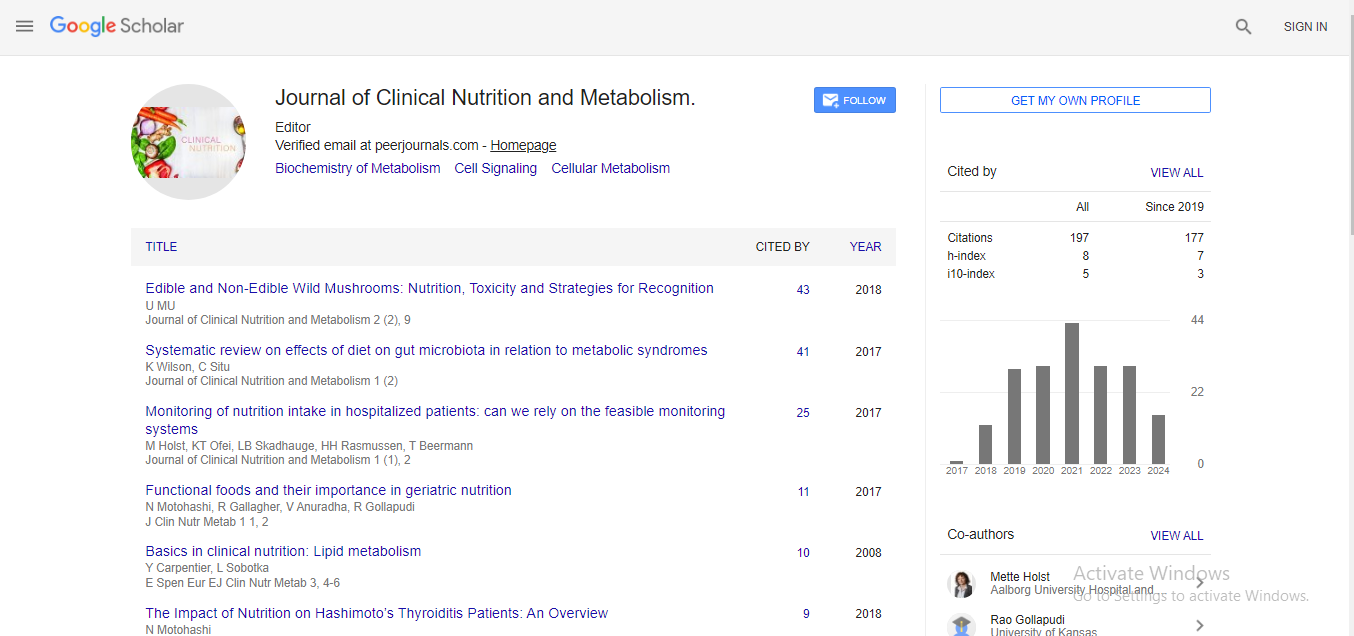Short Communication, J Clin Nutr Metab Vol: 5 Issue: 1
Assessment of serum paraoxanase activity, total oxidant and antioxidant capacity in relation to inflammation in hemodialysis patients - Hazal Kucukkaraca - Ondokuz Mayis University
Hazal Kucukkaraca, Mehtap Unlu Sogut, Mensure Nur Celik and Gul Eda Kilinc Ondokuz Mayis University, Turkey
Keywords: Antioxidant, Hemodialysis
The aim of study was to evaluate the relationship of serum paraoxanase1 (PON1) activity, total oxidant (TOS) and antioxidant (TAS) status with inflammation in hemodialysis patients. 23 patients (diagnosed with hemodialysis) and 27 healthy volunteers were included in study (18-75 years). Rel Assay diagnostics kits were used to determine PON1, arylesterase (ARES), TAS, and TOS in individual serum samples. PON1 and ARES were found to be low in hemodialysis patients. PON1 were determined to be low in 87% of study group and 33% of control group. Individuals who have high PON1 activity were found to have high levels of ARES and HDL (p<0.05). When all subject’s PON1 activity and lipid profile were assessed, PON1 activity had strong positive correlation with HDL, negative correlation with LDL and cholesterol (p<0.05). Negative correlation was observed between CRP and PON1, ARES and TAS, but positive correlation with TOS (p <0.05). CRP levels of hemodialysis patients were 11.7±15.9 mg/L, PON1 values were found to be low in 88% of patients with inflammation. TAS were below normal levels in 91.3% of study group and 70% of control group. However, in all of control group and 86.9% of study group’s TOS were normal. Significant differences were found between PON1, TAS and TOS. Finally, low PON1 activity in hemodialysis patients is associated with reduction in antioxidant capacity of HDL, thereby causing atherosclerosis and inflammation. While decrease in oxidants in hemodialysis patients is though positively, decrease in antioxidants is unwanted. Therefore, TAS and TOS levels are important in terms of immunity and metabolic disorders. Laparoscopic cholecystectomy is the gold standard for the treatment of gallstone disease; however, adverse hemodynamic changes induced by increased intraabdominal pressure due to pneumoperitoneum are known to occur. Herein, we investigated the effects of pneumoperitoneum on oxidative stress markers, including paraoxonase, arylesterase, total oxidant status, and total antioxidant status, during laparoscopic cholecystectomy. Patients that underwent a laparoscopic cholecystectomy were classified as Group I, whereas patients that underwent surgical procedures for an abdominal wall hernia under general anesthesia were classified as Group II. Blood samples were obtained during the preoperative period, the perioperative period, and 24 hours after surgery (postoperative day 1). Leukocyte counts, neutrophil rates, paraoxonase activities, arylesterase activities, and total oxidant and antioxidant status levels were measured. The differences in leukocyte counts and neutrophil rates were not significant between the two groups. In Group I, no significant differences in the total oxidant and antioxidant status levels were identified; however, paraoxonase and arylesterase levels were lower on postoperative day 1. No significant changes were observed in the total oxidant status, total antioxidant status, and paraoxonase or arylesterase activities in Group II. The perioperative total antioxidant status and arylesterase level were higher in Group I in comparison to Group II. This study was performed in Konya Numune State Hospital. Group I patients underwent an LC procedure, whereas Group II patients underwent surgical procedures to treat abdominal wall hernias under general anesthesia. The presence of any of the following conditions was used as an exclusion criterion in this study: diabetes mellitus, neoplastic disease, inflammatory disease (such as infections and autoimmune disorders), hypercholesterolemia, hypertriglyceridemia, use of an antihypertensive medication, lipid-lowering drug use, antioxidant substance use, known secondary hypertension, chronic renal failure, cerebrovascular disease, ischemic heart disease, congestive heart failure, gastrointestinal disease or liver disease. The study protocol was approved by the Ethics Committee of the Meram Faculty of Medicine, Selcuk University, and was conducted according to the Declaration of Helsinki, Good Clinical Practice Guidelines. The participants were informed about the nature of the study and informed consents were obtained. Blood samples were obtained preoperative, perioperative, and 24 hours after surgery. Serum specimens were centrifuged for 15 min at 3000 rpm, transferred to Vol.5 No.1 Short Communication Journal of Clinical Nutrition & Dietetics 2021 Eppendorf tubes, and stored at −80°C. The specimens were used to measure paraoxonase activity, TOS and TAS. The TOS levels of the sera were determined using a novel automated measurement method.27 Oxidants present in the sample oxidize the ferrous ion-o-dianisidine complexes into ferric ions. The oxidation reaction is enhanced by glycerol molecules that are abundantly present in the reaction medium. The ferric ions form a colored complex with xylenol orange in an acidic medium. Therefore, the color intensity, measured spectrophotometrically, is related to the total number of oxidant molecules present in the sample. The assay is calibrated with hydrogen peroxide and the results are expressed in terms of micromolar hydrogen peroxide equivalent per liter (μmol H2O2 equiv).
 Spanish
Spanish  Chinese
Chinese  Russian
Russian  German
German  French
French  Japanese
Japanese  Portuguese
Portuguese  Hindi
Hindi 